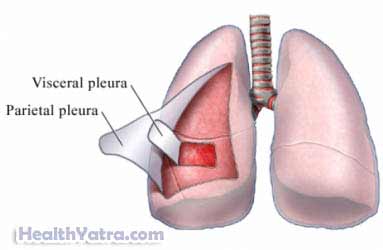Definition
The pleura, is a membrane. It lines the outside of the lungs and the inside of the chest cavity. Pleural mesothelioma is cancer of the pleura.
 Cancer occurs when cells in the body divide without control or order. If cells keep dividing uncontrollably, a mass of tissue forms. This is called a growth or tumor. The term cancer refers to malignant tumors. They can invade nearby tissue and spread to other parts of the body.
Cancer occurs when cells in the body divide without control or order. If cells keep dividing uncontrollably, a mass of tissue forms. This is called a growth or tumor. The term cancer refers to malignant tumors. They can invade nearby tissue and spread to other parts of the body.
Causes
Asbestos is a fibrous mineral that is known to cause cancer. This type of cancer is almost always caused by exposure to it. Even a small amount of exposure can be a risk.
Risk Factors
The main risk factors for pleural mesothelioma are:
- Repeated exposure to asbestos fibers
- Living with a person who works near exposed asbestos fibers
Symptoms
This cancer usually takes a long time to develop. It can take up to 20-40 years. Early signs of pleural mesothelioma include:
- Trouble breathing
- Long-lasting cough
- Pain under the rib cage or in the abdomen
- Pain while breathing
- Weight loss
Many people have no symptoms for a long period of time.
Diagnosis
Your doctor will first ask about your symptoms and medical history. A physical exam will be done. You may be referred to a doctor who specializes in lung problems or cancer. A pulmonologist focuses on the lungs. An oncologist focuses on cancer.
Sometimes it is hard to tell the difference between this and other, more common types of lung cancer. The following tests may be used to help diagnose which disease is present:
Blood tests—including a complete blood count (CBC) and sedimentation rate (checks for the degree of inflammation within the body, which is often increased in the presence of cancer and other inflammatory conditions)
Chest X-ray —may show increased thickness of the pleural lining and/or excess fluid around the lungs
CT scan (CAT scan) —a type of x-ray that uses a computer to make pictures of structures inside the body; will show more detailed images of changes in the pleural lining
MRI (magnetic resonance imaging) —a procedure that uses a magnet, radio waves, and a computer to make pictures of structures inside the body; use is similar to a CT scan
Biopsy —the removal of tissue from the pleura for evaluation under a microscope by a pathologist
These same tests and others may also be used to find out if cancer has spread outside the pleura. It is important to know whether and how far the cancer has spread to plan treatment. This step is called the staging process.
Treatment
Pleural mesothelioma is usually treated with:
- Chemotherapy —use of drugs to kill cancer cells
- Radiation —use of radiation to kill cancer cells and shrink tumors
- Surgery
- Combination of these three treatments
Prevention
The only known way to prevent this cancer is to avoid asbestos. People who could be exposed to asbestos at work include:
- Miners
- Factory workers
- Insulation workers
- Railroad workers
- Ship builders
- Makers of gas masks
- Construction workers
Family members of workers can also be at risk for this cancer. The asbestos fibers can be brought home on clothing. This type of exposure is just as dangerous. It is also very common. About 10% of household contacts of workers will also show signs.
Asbestos can be found from old building insulation, roofing materials, and tiles. Most of the household exposures have been from asbestos brought home from work.
To avoid exposure to asbestos:
- Workers should use proper safety equipment and precautions.
- Workers should use safety measures to avoid bringing asbestos dust home on their clothing.
- Areas of exposed asbestos must be checked by experts. This may be old public buildings and homes with asbestos shingles, tiles, or insulation.
- Exposed areas must be removed by proper means or sealed off.
- A homeowner untrained in asbestos abatement should never attempt to remove asbestos material.
